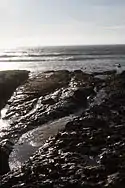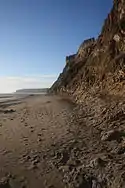Davenport tide pools
The Davenport Tide Pools are located just past the town of Davenport, California in the United States. They are located off Davenport Landing, which is a street off Highway 1.[1] The tide pools are unique due to the ridges that run up and down the tide pools, allowing for different organisms to live close, even though in a normal habitat they would be unable to do so. The Beach is open sunrise to sunset, and is day use only.[2]

Geography
The normal tide pool is separated into two main zones. The Intertidal zone and the Subtidal zone. The Intertidal zone is only covered with sea water during high tide, while the Subtidal zone is closer to the ocean and is covered during low tide. The distinctive separation of organisms into bands along the shoreline is called Zonation. However the Davenport Tide pools are unique in the fact that there are many rifts and ridges in the rock formations, allowing water to reach high on the beach during low tide. This allows species that normally are not found together to live close.
"In contrast, gastropods are not fed upon in proportion to their abundance and availability. Only 2 species of gastropods, the black turban snail, Tegula, and the ribbed limpet, Acwaea scabra, are of any real importance to Pisaster as food. Of these, A. scabra lives higher in the intertidal region than Pisaster, its lower limit overlapping only slightly the upper limit of P. ocliraccrrs." [3]
As shown the Davenport Tide Pool's rifts and ridges allow the Sea Star to reach limpets and snails in high tidal zones. This is a very prominent geographical feature at the Davenport Tide Pools since one would not normally see sea stars so high up the beach.
The tide pools also have multiple sea caves and a smaller rock formation that is reminiscent of the bridges Natural Bridges State Beach. The last prominent geological feature is the high cliffs above the tide pools.
Tide pool life

Some of the most prosperous forms of life at the Davenport Tide Pools are Sea Stars. This is due to the rifts and ridges up and down the tide pools, these allow Sea Stars to move farther up the Tidal zone. Normally Sea Stars are subtidal organisms that live closer to the ocean, because they die when they become too dry. Their prey are Mussels that live up and down the tidal zone, since their hard shells allow them to live in drier areas for longer. The rifts and ridges at the Davenport Tide pools allow the Sea Stars to feed off of Mussels at higher tidal zones during lower tides. Since the Mussels are only a few inches above a rift that is level with the subtidal zone.[4]
Other Tide Pool life include many species of Mussels, Limpets, Seaweed, barnacles, and surf grass. These organisms are also affected by the geographical features of the tide pools. The seaweed and surf grass are able to grow farther up the tidal zones. Many sea stars have adapted to hide under the seaweed and surf, as a way to not dry out. This than allows them to feed on the various higher tidal zone organisms during high tide. The main diet of the Sea Star in Northern California is Mussels Since Davenport Tide Pools has an abundance of Mussels, Sea Stars do not resort to consuming other less desirable organisms.[3]
Gallery
 Sea Star Going to Higher Tidal zone to eat
Sea Star Going to Higher Tidal zone to eat Sea Star under Surf Grass
Sea Star under Surf Grass
References
- U-Pick Berries, Santa Cruz. 8 March 2008
- "UCSC Resource Guide." Ucsc.Edu. University of California, Santa Cruz. 9 March 2008
- The Food of the Starfish, Pisaster Ochraceus Along the California Coast (in Notes and Comment), Howard M. Feder Ecology, Vol. 40, No. 4. (October 1959), pp. 721-724
- Chamberlin, W. S., and Tommy D. Dickey. Exploring the World Ocean. Ed. Margaret J. Kemp. New York: Thomas D. Timp, 2008. 317-320